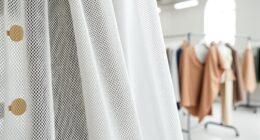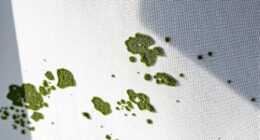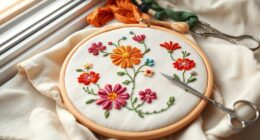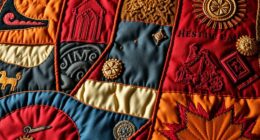Upcycling old clothes is a fantastic way to reduce waste and express your creativity. You can turn worn-out t-shirts into reusable shopping bags or craft denim into stylish accessories like wallets or cushions. Old shirts can become colorful quilts or pillowcases, while jeans work well for belts or tote bags. These projects help extend your clothing’s life and support eco-friendly habits. Keep exploring—they’ll inspire you with even more ideas to creatively transform your wardrobe.
Key Takeaways
- Transform old t-shirts into reusable shopping bags with cutting, knotting, and decorating for eco-friendly practicality.
- Repurpose denim jeans into patchwork cushions, wallets, or braided accessories to extend fabric life sustainably.
- Sew various old shirts into patchwork quilts or pillowcases, creating personalized decorative items that reduce textile waste.
- Use minimal tools and materials to craft durable, eco-conscious projects like tote bags or headbands from recycled fabrics.
- Incorporate creative embellishments or painting to personalize upcycled clothing, promoting sustainable fashion and individual expression.

Ever wondered how to give your old clothes a fresh new life? Upcycling offers a fantastic way to do just that while promoting sustainable fashion and engaging in eco friendly crafts. Instead of tossing out worn-out t-shirts or outdated jeans, you can transform them into stylish, functional pieces that reflect your creativity and care for the environment. This approach not only reduces waste but also minimizes your carbon footprint, making your wardrobe more eco-conscious.
Give your clothes a new life with upcycling—promote sustainability and express your creativity.
One simple idea is to turn old t-shirts into reusable shopping bags. Cut the shirts into strips or shapes, sew or knot the edges together, and you’ve got a sturdy bag perfect for groceries or daily errands. It’s a practical project that uses materials you already have, keeping waste out of landfills. Plus, making your own bags aligns perfectly with sustainable fashion goals by reducing reliance on single-use plastic bags. You can add embellishments or paint designs for a personal touch, turning a plain shirt into a one-of-a-kind accessory. This kind of eco friendly craft encourages you to think creatively about repurposing textiles rather than buying new items.
Another idea is to repurpose old jeans into stylish accessories. Cut and sew the denim into patchwork cushions, wallets, or even a trendy tote bag. Denim’s durability makes it ideal for upcycling into long-lasting home decor or everyday essentials. You can also cut strips to create braided belts or headbands, adding a unique element to your wardrobe. These projects not only give your clothes a second life but also promote sustainable fashion by extending the lifespan of the fabric. You get to enjoy the satisfaction of creating something useful and fashionable while reducing textile waste.
If you have shirts with interesting patterns or textures, consider turning them into patchwork quilts or pillowcases. Sew different pieces together for a colorful, personalized design that’s both functional and beautiful. This eco friendly craft allows you to preserve memories or favorite prints in a new form, giving sentimental value to old garments. It’s a perfect way to keep your clothing out of the trash while crafting something cozy and decorative. Plus, these projects often require minimal materials and can be completed with basic sewing skills, making them accessible for beginners. Incorporating sustainable practices like upcycling can also be supported by tools and techniques that ensure your projects are both eco-conscious and durable.
Frequently Asked Questions
What Tools Are Best for Fabric Upcycling Projects?
For fabric upcycling projects, you’ll want sharp fabric scissors to make precise cuts and a rotary cutter for clean, straight edges. Fabric scissors are ideal for detailed work, while a rotary cutter speeds up larger cuts on layers of fabric. Keep a cutting mat underneath to protect surfaces. Both tools help you achieve professional-looking results, making your upcycling projects easier and more enjoyable.
How Can I Upcycle Clothes Without Sewing Skills?
Did you know over 92 million tons of textile waste are generated annually? You can upcycle clothes without sewing by trying fabric painting to add designs or patterns and turning old shirts into stylish accessories like headbands or bags. These simple methods need no sewing skills, just some creativity and basic supplies. You’ll give new life to old clothes while reducing waste and creating unique, personalized items effortlessly.
What Are Eco-Friendly Dyes for Fabric Upcycling?
You can use eco-friendly dyes like natural pigments and plant-based dyes for fabric upcycling. These dyes come from sources such as berries, leaves, roots, and flowers, making them a sustainable choice. Simply extract the color, then soak your clothes in the dye bath. This method not only reduces chemical use but also creates unique, vibrant patterns, giving your old clothes a fresh, eco-conscious makeover.
How Do I Choose Which Clothes to Upcycle?
You should choose clothes based on fabric selection and upcycling inspiration. Look for fabrics that are durable, like denim or sturdy cotton, which hold up well with creative reuse. Avoid delicate or heavily worn items that might not transform nicely. Keep your inspiration in mind—whether it’s turning a shirt into a tote or a jacket into a wall hanging—and pick pieces that spark your creativity and suit your project ideas.
Are There Safety Tips for Upcycling Old Textiles?
Safety first, because a stitch in time saves nine. Always wear safety gear like gloves and masks when handling fabrics, especially if they’re old or stained. Use sharp scissors carefully and work in a well-ventilated area to avoid inhaling dust or fibers. Keep your workspace tidy, and wash your hands afterward. These simple precautions guarantee you enjoy upcycling without any mishaps.
Conclusion
By upcycling your old clothes, you breathe new life into forgotten fabrics, turning trash into treasure. Think of each piece as a blank canvas waiting for your creative touch. Not only do you reduce waste, but you also craft unique items that reflect your style. So, roll up your sleeves and let your imagination run wild—your wardrobe and the planet will thank you for it. After all, with a little effort, you can make magic happen from what once seemed useless.









